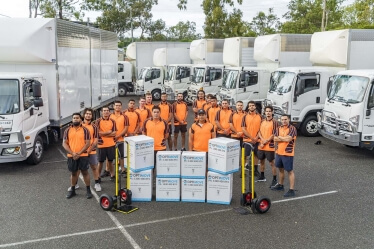Help Your Plants Survive a Relocation With These Tips
Moving to a new home can be an exciting adventure, but it can also be a stressful time for your beloved plants. Plants are sensitive to environmental changes and moving can disrupt their routine and cause distress. However, with proper planning and care, you can help your plants survive the relocation and thrive in their new surroundings. Here are some essential tips to ensure a smooth transition for your plants during a move:
Plan Ahead:
Before you start packing, consider the specific needs of your plants and plan accordingly.
Research your new location
Learn about the climate, lighting conditions, and other environmental factors at your new home. This information will help you determine which plants will adapt well and which may struggle in the new environment.
Assess your plants
Evaluate the health and condition of your plants. Consider whether bringing all your plants with you is feasible or if it’s better to give some away to friends or family. This will reduce the number of plants you must transport and ensure you take only the healthiest specimens.
Choose the right time
It’s best to move plants during the dormant season or when they are less active. This reduces the shock of relocation and allows them to recover more easily. Avoid moving them during extreme weather conditions.
When moving plants, timing is crucial. Select a time when plants are dormant or less active to minimize the stress of relocation. Avoid extreme weather conditions that could harm them. Research the specific needs of each plant and gather necessary supplies in advance. Prune and trim the plants before the move to reduce their size and encourage new growth. Transplant carefully, retaining as much of the root system as possible. Ensure containers are clean and have drainage holes. Water plants adequately before the move and protect them during transportation from excessive sunlight. Acclimate gradually to the new environment and provide proper care post-relocation.
Prepare Your Plants:
Several weeks before the move, prepare your plants for relocation.
Repot if necessary
If your plants have outgrown their pots or if their soil is depleted, consider repotting them into new, larger containers, like plastic pots. Plastic pots are cheap alternatives for the transit and you can move them to ceramic pots upon arrival at the destination. This will give them room to grow and provide a fresh start in their new home. After repotting, you might need to wrap the pots with bubble wrap.
Prune and trim
Prune any leggy or overgrown branches to promote healthy growth and reduce the overall size of your plants. This will make transporting them easier and help them bounce back faster after the move. Remove dead leaves prior to repotting.
Minimise Stress During Transportation:
- Water adequately: A day or two before the move, water your plants thoroughly but avoid overwatering. Moist soil will help keep the plants hydrated during transit.
- Protect foliage: Cover your plants with lightweight, breathable materials such as paper or fabric to prevent damage to leaves and branches. This will shield them from wind, temperature fluctuations, and potential breakage.
- Secure transportation: Place your potted plants in sturdy boxes or containers that can be closed securely. Make sure they fit snugly to avoid excessive movement during transit. Lay larger plants flat on their sides if possible to prevent them from tipping over.
The Day of the Move:
Keep the plants in a temperate environment
On a moving day, try to keep your plants in a shaded, temperature-controlled area. Extreme temperatures can harm their health, so avoid exposure to direct sunlight or harsh weather conditions.
Load them last
When loading your belongings onto the moving truck, try to load your plants last. This will minimise their time in a confined space and reduce the risk of damage from shifting objects.
Settling In at the New Home:
Unpack and acclimate
When arriving at your new home, unpack your plants as soon as possible. Please place them in their designated spots and allow them to adapt to the new environment.
Gradual light exposure
If your new home has different lighting conditions, gradually expose your plants to the new light levels. Start with a few hours of indirect light and gradually increase the duration over a week or two.
Water and care
Resume your regular watering and care routine based on the specific needs of each plant. Take note of any changes in their growth or condition and adjust your care accordingly.
Be Patient:
Give your plants time to adjust
Moving can be stressful, and it may take some time to adapt to their new surroundings. Be patient and allow them to settle in at their own pace.
Observe and adapt
Keep a close eye on your plants during the first few weeks in their new home. Watch for signs of stress or any issues that may arise. Adjust their care as necessary, providing extra attention or changing their placement.
Seek Professional Advice for Sensitive Plants:
Regarding sensitive plants, seeking professional advice can be beneficial to ensure their survival and well-being during a relocation. Here are some reasons why consulting a plant specialist or horticulturist is essential:
Expert knowledge
Plant specialists and horticulturists have in-depth knowledge and expertise about various plant species. They can provide specific guidance on caring for sensitive plants during a move, considering their unique requirements and vulnerabilities.
Tailored recommendations
Each sensitive plant may have specific needs and sensitivities that require individualised care. Professionals can assess your plants’ condition, consider their species, growth stage, and environmental requirements, and provide personalised recommendations to ensure their successful relocation.
Prevention and mitigation of stress
Sensitive plants are more prone to anxiety and may require extra precautions during a move. Professionals can advise on stress-reducing techniques, such as specialised handling, controlled lighting and temperature conditions, and protective measures to minimise potential damage or shock during transportation.
Pest and disease management
Sensitive plants are often more susceptible to pests and diseases. Professionals can help you identify and address any existing pest or disease issues before the move and recommend preventive measures to protect your plants during and after the relocation.
Troubleshooting and support
In case of any unexpected challenges or problems during the move, having access to professional advice can be invaluable. They can assist with troubleshooting issues, guide plant recovery strategies, and offer ongoing support as you navigate the relocation process.
Benefits of Having an Plant Professional
When selecting a professional, consider contacting local nurseries, garden centres, or botanical gardens for recommendations. They can connect you with experts who specialise in the care of sensitive plants. Alternatively, you may also find online resources and forums where you can seek advice from experienced gardeners and plant enthusiasts.
By consulting with professionals, you can gain the knowledge and guidance necessary to ensure the well-being of your sensitive large plants during a relocation. Their expertise will help minimise stress, increase the chances of successful adaptation, and provide the best care for your plants in their new home.
Celebrate Success and Growth
Celebrating the success and growth of your plants after relocation is a beautiful way to appreciate the resilience and beauty they bring to your new home. Here are some ideas on how to celebrate and acknowledge the accomplishments of your plants:
Document their progress
Take photos of your plants before, during, and after the move to create a visual record of their growth and transformation. It’s a great way to reflect on their journey and see their positive changes.
Share your success
Share your plant relocation success story with friends, family, or fellow plant enthusiasts. Post updates on social media or participate in online gardening communities to inspire others and receive encouragement and support.
Host a plant housewarming party
Invite friends and loved ones to celebrate your new home and its thriving leafy plants. Share stories about the challenges and triumphs of moving with your outdoor plants. Arrange a gathering centred around your place plants, such as a plant-themed brunch or a garden tour.
Create a plant journal
Keep a journal to record the milestones, growth patterns, and any special moments related to your plants. Write about your experiences, observations, and lessons learned during relocation. It will serve as a meaningful keepsake and a reminder of your plant’s resilience.
Propagate and share the joy
If your smaller plants have multiplied during the relocation or have successfully propagated new plants, consider sharing the happiness by gifting cuttings or smaller plants to friends, family, or neighbours. It not only spreads the beauty of nature but also serves as a symbol of growth and abundance.
Appreciate their presence
Take a moment each day to appreciate the beauty and benefits your indoor plants bring to your new home. Observe their vibrant colours, soothing presence, and how they enhance your living space. Express gratitude for their resilience and the joy they bring to your life.
Conclusion
Moving plants can be daunting, but you can make the transition easier with careful preparation and the proper steps. Hiring Optimove to help you move your potted plants ensures that your plants are taken care of safely and efficiently. Their expert knowledge and experience can help ensure that your indoor plants arrive at their new home safely and are ready to thrive. You can smoothly transition your garden plants into their new environment with the proper care and patience.








































